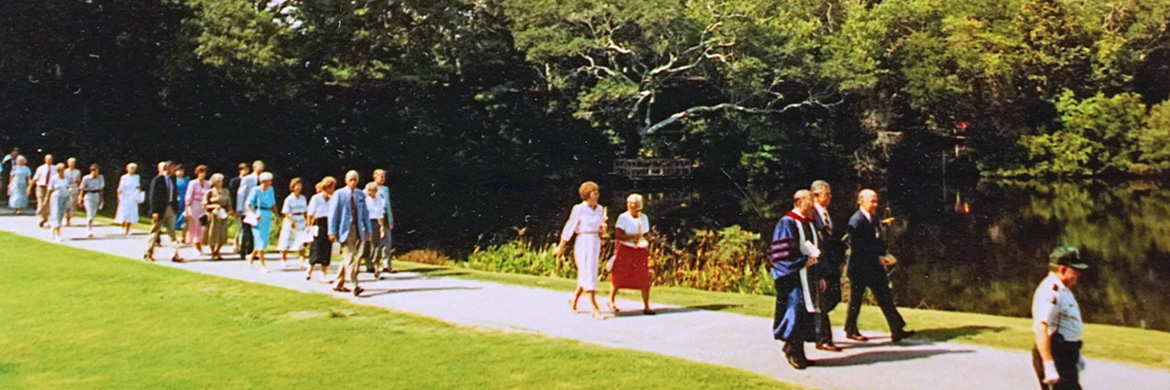In 1974, when Amelia Island Plantation was being developed, a small group of Amelia Island Company employees and early property owners felt the need to have a church established on the south end of the Island. These residents represented a variety of Christian traditions as well as personal and career backgrounds. They were, however, joined in their belief in Jesus Christ as Lord and Savior, a desire to worship Him, and to serve Him in their community.
The group began to hold Sunday worship meetings wherever space was available on the Plantation, using such diverse locations as the former Orvis shop, the Amelia Inn, or the Beach Club. Ministers from churches in the surrounding area came to lead the service each week. The few Bibles, hymnals, and other supplies owned by the group were transported in a rolling wooden chest, which was named “The Ark.”
In 1977 the congregation, numbering 84, adopted a constitution naming Amelia Plantation Chapel as an interdenominational church with governance vested in a Governing Board. On March 15, 1977, the State of Florida issued a Certificate of Incorporation which recognized Amelia Plantation Chapel, Inc. as a non-profit, tax-exempt entity.
As the congregation grew, it became apparent that a permanent place of worship was needed. A building fund was established and an outreach program to attract new members was initiated.
In 1986 the first full-time pastor, Rev. Don McGarity, was hired.
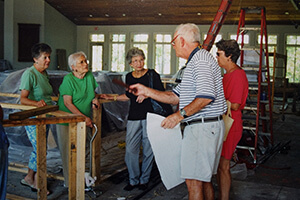
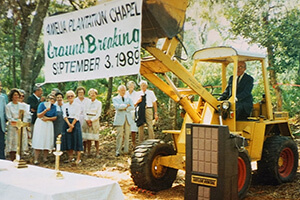
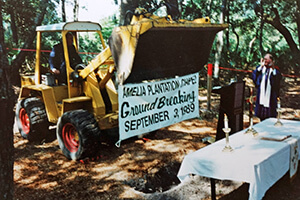
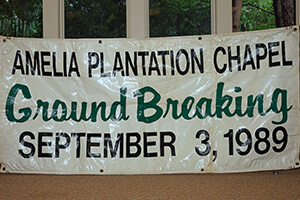
In 1988 an architectural firm, Beer and Associates, was hired to submit plans for a church building. With careful and prayerful intent, a site was purchased, located outside of the entry gates to the residential areas of the Plantation to make the Chapel welcoming to the entire surrounding community.
On September 3, 1989, members and guests held a unique groundbreaking ceremony in which participants co-mingled soils from their home churches into the foundation of the planned building. This ceremony symbolized both their diverse backgrounds and their unity in Christ.
The new church would be a 6,633 square-foot structure with a sanctuary seating 350, a choir loft with space for 30, a sacristy, two offices, a narthex, a fellowship room, and an unfinished balcony. A parking lot and an adjacent memorial garden were also elements of the Chapel site. Construction was begun on December 8, 1989.
The almost-completed building was filled to over-flowing for the first service on July 29, 1990. The formal dedication of the Chapel was held on October 28, 1989. The final cost of the project was $1.3 million. The construction loan was fully satisfied in March of 1992. The new building had many striking features. The hand-carved entry doors created by artist George Pandolph welcome arriving worshippers. The large beveled glass cross in the Chancel, designed and installed by monks from the Monastery of the Holy Spirit in Conyers, Georgia, was the focal point upon entering. This cross, combined with its clear glass side panels and the clear windows down each side of the sanctuary welcomed the outside beauty of nature into the inside beauty of the Chapel.
During the ensuing years, additional features have been added to meet the worship needs of an ever-growing congregation. On March 27, 1994, a columbarium was dedicated in the location adjacent to the Memorial Garden. This structure held spaces for 79 double and 22 single niches. Recent improvements and expansions have been made to both the garden and the columbarium.
A membership of over 400 had made the need for new space acute by early in the twenty-first century. A “Realizing the Vision” campaign was launched and over $2 million dollars was raised to remodel the Sanctuary, add a music suite, and complete the balcony. The old fellowship room was converted into a nursery. In addition, new offices, a library, a room for classes and Bible studies, a Fellowship Hall with a large kitchen facility, and an uncompleted second floor were constructed. During the period of construction, worship services were held in meeting rooms or a large tent located at the Racquet Park Conference Center. The dedication of the expanded campus was held on October 16, 2005. All debt for this project was paid by early 2008.
Continued growth soon made the completion of the second floor of the Fellowship Hall building a reality. This area provided additional classroom and office space as well as a much-needed storage area. Necessary funding was quickly raised and the space was completed in October 2013.
Additional gifts and bequests have continued to enhance the worship experience at the Chapel. In 2006 a group of donors purchased a bronze sculpture of The Sower, located in the small courtyard between the buildings. This beautiful art piece has come to symbolize the mission of the Chapel. A generous donor gifted the Chapel with a Diane Bish organ in 2007. This organ has greatly enhanced the outstanding music ministry. A bequest of a new carillon was made in 2016. The chimes sound across the Plantation three times daily
A striking feature of the Chapel is the needlepoint used throughout. Five large banners are displayed showing the seasons of the church year. The four chairs in the Chancel represent elements of The Trinity. A kneeling bench is used for special prayers and at wedding ceremonies. Paraments for the pulpit and lectern were gifts from the designer, Susan Witt of Columbus, Georgia. Fourteen members of the Chapel completed this project within eighteen months. The needlepoint was dedicated in January 2004.
The Chapel annually supports 37 missions locally and around the world. Thirty percent of the yearly budget is earmarked for these outreach programs.
In January of 2010, the Chapel initiated a second worship service at 11:15. This more informal service offers the Sacrament of Communion each week.
The Chapel hosts Sunday Coffee fellowship, a Sunday School class, multiple weekly Bible studies, multiple weekly Bible studies, as well as numerous special events. Vacation Bible School is held for children each summer. Small groups meet socially in Tables of Eight luncheons or dinners. The entire membership comes together for Fall Festival in October and an oyster roast in the spring.
We celebrated the thirtieth anniversary of the dedication of the church building in October 2020.
The symbolism of the Chapel was carefully designed to reflect and represent the theme of light. It is repeatedly represented in the art forms and design of the building.
So often when we come to the Chapel, the doors are open and one does not see the beauty of the carving and the significance of the representation.
The emphasis in the Chapel has always been “light,” as it has been throughout the Bible itself. “I am the light of the world”, declared our Savior. The Psalmist states, ‘’The Lord is my light and my salvation.”
The copper cross symbolizes that only through the darkness of the Cross of Christ can we partake of the light of the resurrection.
The doors, beautifully hand carved by master craftsman and artist, George Randolph of Mount Dora, Florida, depict the light of the first resurrection morning. It is through the light of this dawning that we find salvation through Christ’s sacrifice, and only through our faith and belief are we to gain the light of everlasting life. The sea oats symbolize that through death we attain new and eternal life.

Chapel Banners
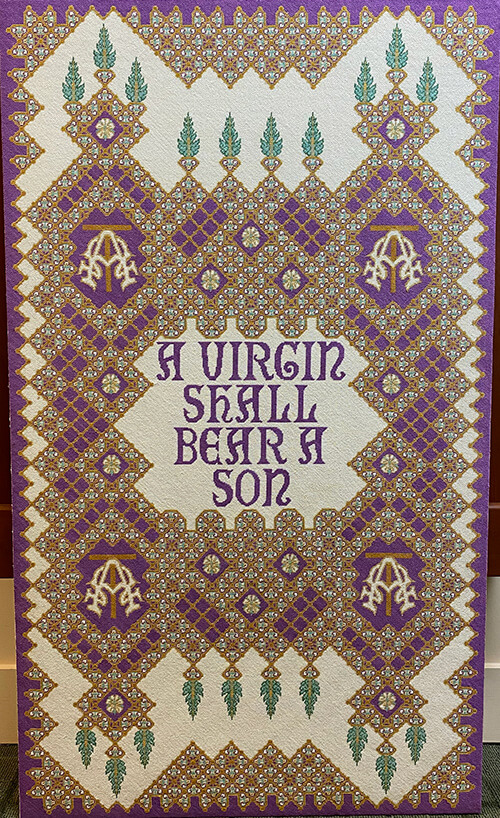
The Advent Banner. . .
The major symbols used in the Advent banner are a scroll, the Messianic Rose, and the Alpha and Omega monogram. The scroll proclaims the prophecy from Isaiah that “a virgin will bear a son.” The Messiah is depicted in the Old Testament as a rose. In the New Testament He is seen as Alpha and Omega, the beginning and the end. Purple is the predominant color of this banner.
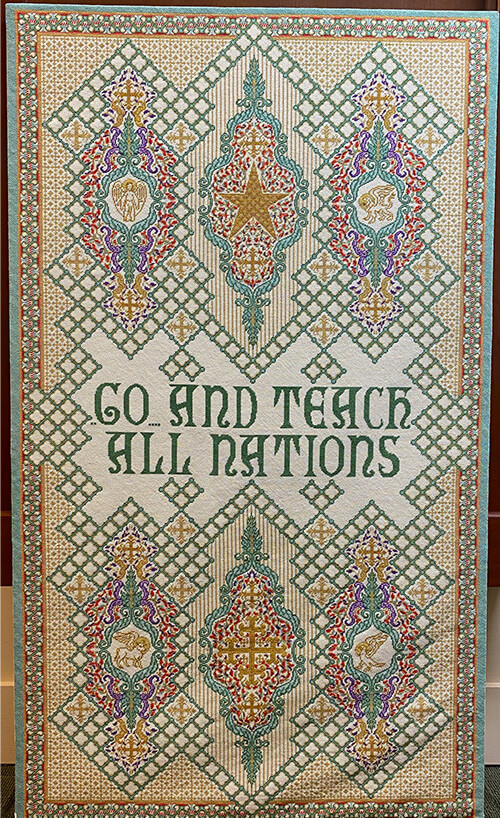
The Epiphany Banner. . .
The five-pointed star is the symbol of Epiphany when Christ was made manifest to the Gentiles by the guiding of the Star. In Numbers 24:17 we read, “There shall come a star out of Jacob, and a scepter shall rise out of Israel. . .” Isaiah 60:3 says, “And the Gentiles shall come to the brightness of thy rising.” The Gospel, or the Good News, of the Savior is depicted by the symbols of a winged man for Matthew, a winged lion for Mark, a winged ox for Luke, and an eagle for John. This banner reminds us of the Great Commission which instructs Christians to “go and teach all nations.”
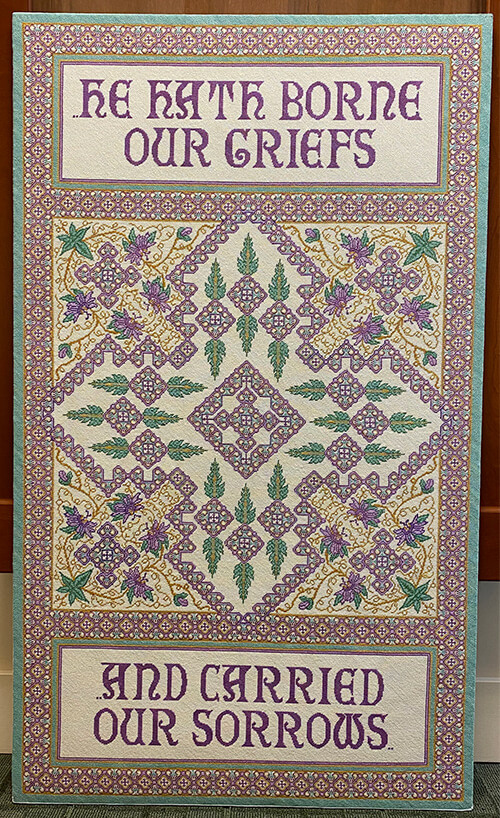
The Lenten Banner. . .
The Lenten Banner depicts Christ’s suffering and sacrifice. The Cross and all it represents is the main symbol. Other symbols of the Passion of Christ are the passion flower, a nimbus, a spear, and the disciples who fled. The Scripture, “He hath borne our griefs and carried our sorrows,” offers hope in the midst of looking backward to his suffering.
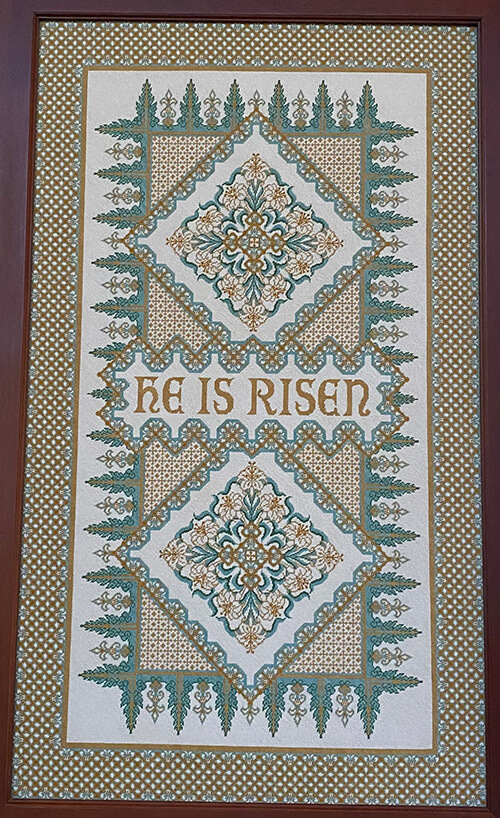
The Easter Banner. . .
The symbol of the lily is dominant in the Easter banner which celebrates the Resurrection. The Easter lily comes from a bulb which appears to be dead but when planted in the earth it sprouts forth in new life. The Scripture, “He is Risen,” gives hope for the future with the risen Christ.

The Pentecost Banner. . .
Pentecost celebrates the birth of the Church. The gift of the Holy Spirit is symbolized in the descending dove, accompanied by tongues of fire. Vines and fruit shown in the banner represent the church as described in John 15.

The Chairs. . .
The four chairs in the Chancel of the Chapel represent each of the Persons of the Trinity and the Trinity itself. The chair symbolizing God the Father depicts the Six-Pointed Star. Each point of the star represents an attribute of God. In the seat of God’s chair is the symbol of love, which is the red rose. The symbol for God the Son is the Alpha and Omega monogram, which are the first and last letters of the Greek alphabet, symbolizing that Christ is the beginning and the end. The seat of the chair contains olive branches, the symbol of peace. The dove is the symbol for God the Holy Spirit. The dove is the embodiment of power and life, as is the believer who is empowered by the Holy Spirit. The seat contains grapes, the symbol for the Fruit of the Spirit. The symbol for the Trinity is the fleur-de-lis with its three divisions. The seat design is wheat which represents the harvest of believers. God uses believers in the gathering of the harvest of souls.

The Wedding Kneeler. . .
Pentecost celebrates the birth of the Church. The gift of the Holy Spirit is symbolized in the descending dove, accompanied by tongues of fire. Vines and fruit shown in the banner represent the church as described in John 15.
Meditation Garden
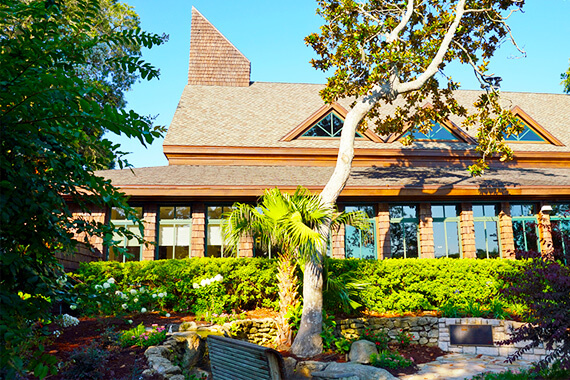 When Chapel members and visitors wish to pray or ponder, the Meditation Garden affords an idyllic opportunity to do that. Beautiful flowers, plantings, and a waterfall, with several benches, offer an ambiance most conducive for meditation. But the primary purpose of the Meditation Garden is to provide a final resting place for departed members of the Chapel congregation and their families.
When Chapel members and visitors wish to pray or ponder, the Meditation Garden affords an idyllic opportunity to do that. Beautiful flowers, plantings, and a waterfall, with several benches, offer an ambiance most conducive for meditation. But the primary purpose of the Meditation Garden is to provide a final resting place for departed members of the Chapel congregation and their families.
In 1994, a handsome masonry Columbarium was designed and built with niches for 101 urns containing the ashes of those gone to their eternal reward. By 2007, all the Columbarium niches had been reserved by Chapel members, and expansion of the facilities was necessary. A second Columbarium was designed and constructed in 2008 with an appearance similar to the original. Columbarium II, as it is named, offers almost as many niches as the original, although the structure is smaller. In addition, a Memorial Garden was designed and built that same year that provides an area for direct interment of ashes of the departed in the ground.
Everyone is welcome to visit the Chapel Meditation Garden, whether to say a prayer for a departed loved one or to simply sit and reflect on the beauty of God’s world. Chapel members may obtain information on reserving space for the interment of loved ones by contacting the Chapel office.
Members of the Chapel congregation may reserve a niche in Columbarium II or a plot in the Memorial Garden for the interment of the ashes of the member or the member’s immediate family. The original Columbarium (Columbarium I) is fully reserved. Requests for exception to the limit on the identity of those to be interred must be referred to the Chapel Governing Board.
Those interested in reserving a Meditation Garden space may obtain a folder from the Chapel office which contains complete information on terms and conditions for use of the niches or plots. The Meditation Garden Guidelines found in the folder provide answers to many questions commonly asked.
The cost of a reservation in Columbarium is $2,000 per individual niche, and the Memorial Garden is $1,000 per individual internment. Niches in the Columbarium are sized for either one or two interments, using urns supplied by the Chapel. The cost of urns is not included in the reservation fee. All plots in Memorial Garden are single but adjacent plots may be reserved. The Chapel assumes the obligation of perpetual care of the Meditation Garden as part of the agreement with those who reserve space for loved ones or themselves.

